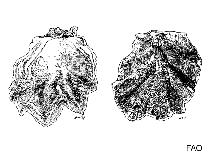Magallana bilineata (Röding, 1798)
Indian backwater oyster
Upload your photos
Google image | No image available for this species;
drawing shows typical species in Ostreidae.
Google image | No image available for this species;
drawing shows typical species in Ostreidae.
Classification / Names Common names | Synonyms | CoL | ITIS | WoRMS
Bivalvia | Ostreida | Ostreidae
Environment: milieu / climate zone / depth range / distribution range Ecology
Benthic; brackish; depth range 0 - 300 m (Ref. 356). Tropical, preferred 28°C (Ref. 107945); 26°N - 5°N, 64°E - 94°E
Distribution Countries | FAO areas | Ecosystems | Occurrences | Introductions
Indo-Pacific.
Length at first maturity / Size / Weight / Age
Maturity: Lm ? range ? - ? cm Max length : 20.9 cm SHL male/unsexed; (Ref. 96220); max. reported age: 4 years (Ref. 8702)
Mainly inhabits brackish waters, wherein it occurs as thick beds in estuaries, backwaters, ports and harbors (Ref. 7693). Found in areas with somewhat reduced salinity within intertidal and shallow subtidal waters (Ref. 348). Though sporadic, it is also found on corals, rocks, hard objects or growing in bunches, on various soft bottoms to a depth of about 4 m (Refs. 101354, 53, 348 ). Feeds on diatoms, zooplankton and detritus (Ref. 107090). Also in Ref. 115735.
Life cycle and mating behavior Maturity | Reproduction | Spawning | Eggs | Fecundity | Larvae
Members of the class Bivalvia are mostly gonochoric, some are protandric hermaphrodites. Life cycle: Embryos develop into free-swimming trocophore larvae, succeeded by the bivalve veliger, resembling a miniature clam.
Main reference
References | Coordinator | Collaborators
SAUP Database. 2006. (Ref. 356)
IUCN Red List Status (Ref. 130435)
CITES status (Ref. 108899)
Not Evaluated
CMS (Ref. 116361)
Not Evaluated
Threat to humans
Human uses
Fisheries: commercial
FAO - Aquaculture: production; | FishSource | Sea Around Us
Tools
More information
Internet sources
BHL | BOLD Systems | CISTI | DiscoverLife | FAO(; publication : search) | Fishipedia | GenBank (genome, nucleotide) | GloBI | Gomexsi | Google Books | Google Scholar | Google | PubMed | Tree of Life | Wikipedia (Go, Search) | Zoological Record



